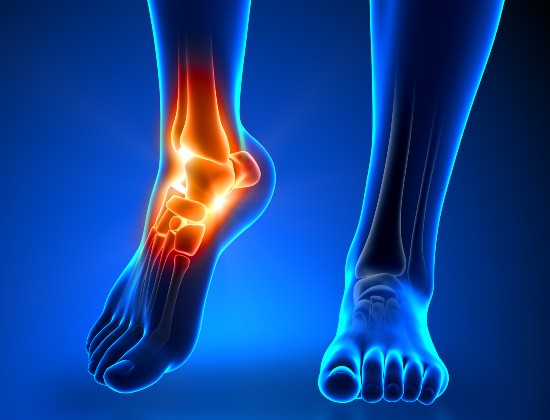Achilles tendon rupture
The Achilles tendon is the large tendon at the back of your ankle. It connects the calf muscle to the heel bone and is important to enable you to bring the foot downwards, go on tip-toe, and to provide a good push-off when walking or running.
What is a rupture of the Achilles tendon?
This is a tear of the tendon which may be ‘partial’ or ‘complete’. In complete ruptures there is total loss of the connection between the muscles in the back of your calf and the heel bone.
How common is it?
Achilles ruptures (tears) occur in about 1 in 5,000 people. They are more common in men between the ages of 30-50.
How does it happen?
It often happens during sports when training is too hard and/or the tendon is weak. Other factors such as ageing, the long-term use of corticosteroids, steroid injections near the tendon and certain antibiotics can all weaken the Achilles tendon over time.
What are the symptoms?
Symptoms usually include a sudden pain at the back of the ankle (although not everyone experiences pain) and, in some cases, you will hear a snap. Afterwards it will be difficult to walk. You may be able to feel the gap of the torn tendon, with swelling and bruising developing soon afterwards.
What should you do?
If you think you may have torn your Achilles tendon it’s better to get it checked as soon as possible as this will make it more treatable and can result in a better long term outcome.
How is it diagnosed?
Usually, a discussion of your symptoms and the circumstances in which the injury happened, along with a medical examination, is enough to diagnose a rupture. You may also be offered an ultrasound or MRI scan to confirm the diagnosis.
How is it treated?
If you think you may have suffered a complete rupture, you should seek urgent medical advice. This is because, without treatment, the tendon may heal incorrectly, causing weakness in the calf muscles and difficulty in running - or even walking - in the future.
Non-operative treatment: this allows the tendon to heal naturally by keeping its two torn ends close together in a plaster cast or a brace for several weeks. As long as the two ends of your torn Achilles tendon are close together they will re-attach to each other naturally. It is essential that the appropriate plaster/boot is used as soon after the injury as possible so the tendon heals at its correct length. Not having an operation means:
- No surgical risks of anaesthesia, wound problems, nerve injury or infection
- Slightly increased risk of re-rupture compared to surgical treatment
- Slightly longer rehabilitation period
- You may notice some weakness when doing exercise or sports
Surgery: you may be advised to have an operation to repair the tendon as this can lead to a more rapid recovery and return to sporting activities. Surgical repair also has a lower rate of re-rupture and is stronger. With Achilles tendon repair, the two torn ends are brought together and held with stitches until they heal. Afterwards you will wear a brace on the leg until it has healed. Having an operation means:
- 5-10% risk of wound problems, nerve injury or infection
- Small risk of re-rupture (2-5%, less than in non-operative treatment)
- Quick rehabilitation period
- Probably less calf weakness when doing exercise or sports
Getting back to normal
If the tendon is treated promptly then most people are able to return to their previous sporting activities. After an operation and physiotherapy, you can usually return to jogging after three months, and running/jumping sports by six months.
When can I start to drive again?
The DVLA states that it’s the responsibility of the driver to ensure they are always in control of the vehicle. A good guide is if you can stamp down hard with your foot to stop the car during an emergency stop.
Although your specialist will advise you about when it’s safe to start driving again, it remains your responsibility to drive safely and you should also check with your vehicle insurer to confirm you are covered.
When can I return to work?
This depends on the type of work you do and how quickly you recover. As a general guide, if your job involves sitting down for most of the time, you should be able to return to work after a week; if it involves manual work, you may need to have 12-16 weeks off.
Important: This information is only a guideline to help you understand your treatment and what to expect. Everyone is different and your rehabilitation may be quicker or slower than other people’s. Please contact us for advice if you’re worried about any aspect of your health or recovery.


